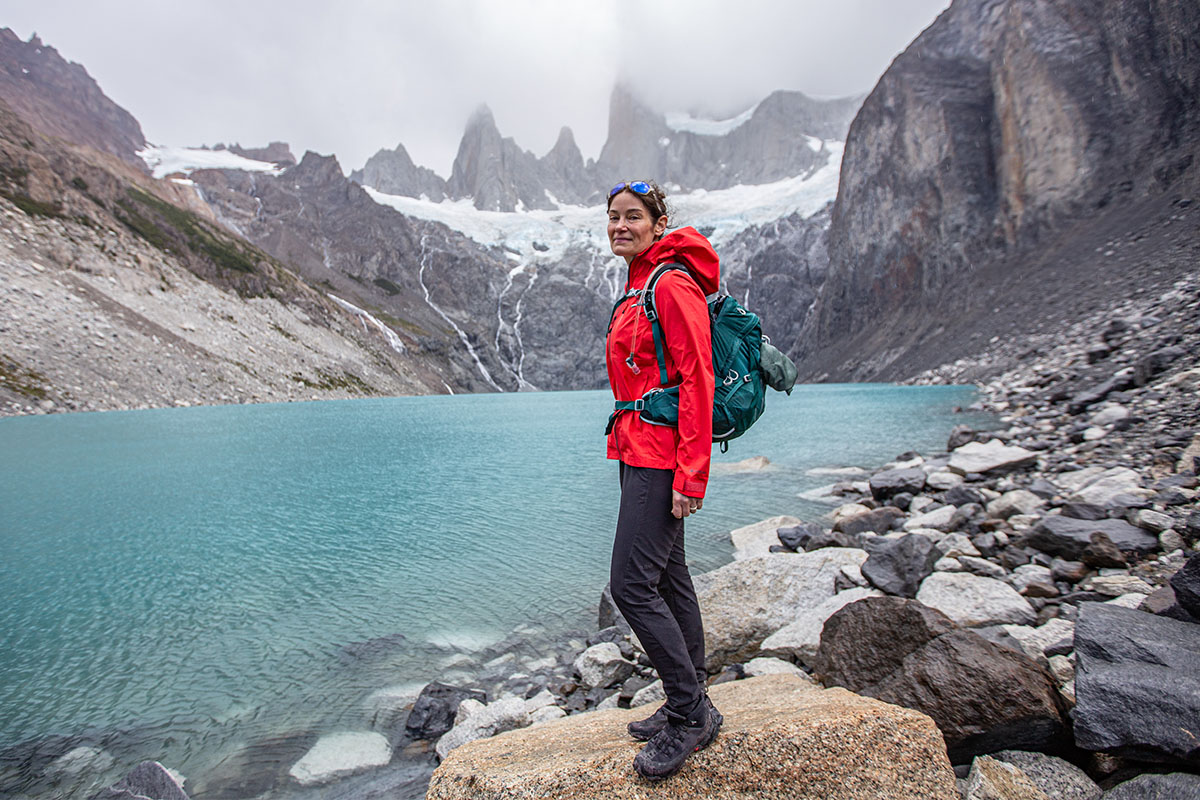
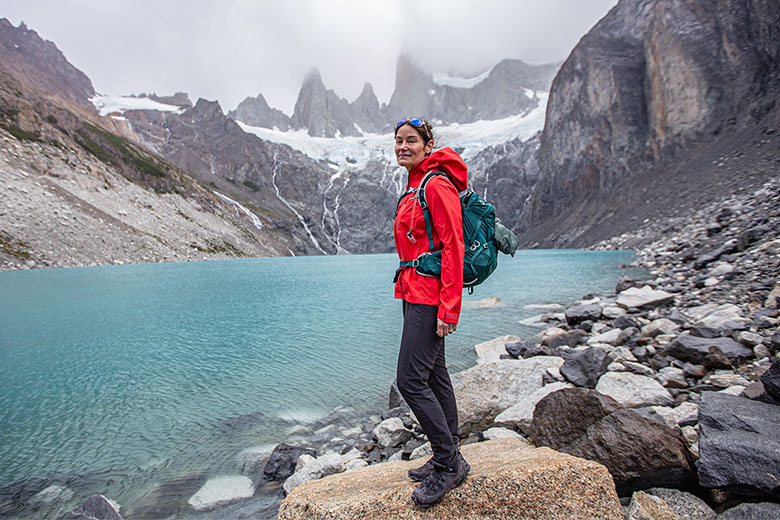
Price: $300
Weight: 12.7 oz.
Waterproofing: 2L Gore-Tex Paclite Titanium & 2L Gore-Tex w/ Stretch
What we like: Highly competitive mix of protection, mobility, and durability for everyday and light outdoor use.
What we don’t: On the pricier and heavier end; interior is prone to growing clammy during exertion.
See the Women's OR Aspire Super Stretch See the Men's OR Foray Super Stretch
Outdoor Research’s Aspire is their core women’s rain shell, and the Super Stretch version tacks on a stretchy Gore-Tex panel at the back for added mobility. We recently put the jacket through its paces in southern Patagonia, where it impressed us with its effective combination of protection, durability, and freedom of movement—not to mention ventilation, which is top-notch thanks to the clever TorsoFlo design. The interior is prone to growing clammy when working hard, and the jacket isn’t a weight or price leader, but it’s a great quiver-of-one shell for everyday wear and non-technical outdoor pursuits like hiking and backpacking. Below we break down our experiences with the Aspire Super Stretch. To see how it stacks up to the competition, see our article on the best women’s rain jackets.
Southern Patagonia was an excellent testing ground for the Outdoor Research Aspire Super Stretch Jacket, and I’m happy to report that it held up well to the unseasonably wet weather and notoriously strong winds. For waterproofing, OR opted for a proven 2-layer Gore-Tex Paclite build that’s provided stalwart protection in everything from mist to hail and torrential rain. The stretchy back panel—which is made of Gore-Tex with Stretch Technology—has performed equally well with no signs of wetting out. I did notice the sleeves growing dark from moisture at one point during heavy rainfall (we had similar experiences with the standard Aspire II GTX Jacket), but it never made its way to my baselayers. Tack on full seam taping and a quality DWR coating, and the Aspire Super Stretch is overall a very capable and reliable companion in wet weather.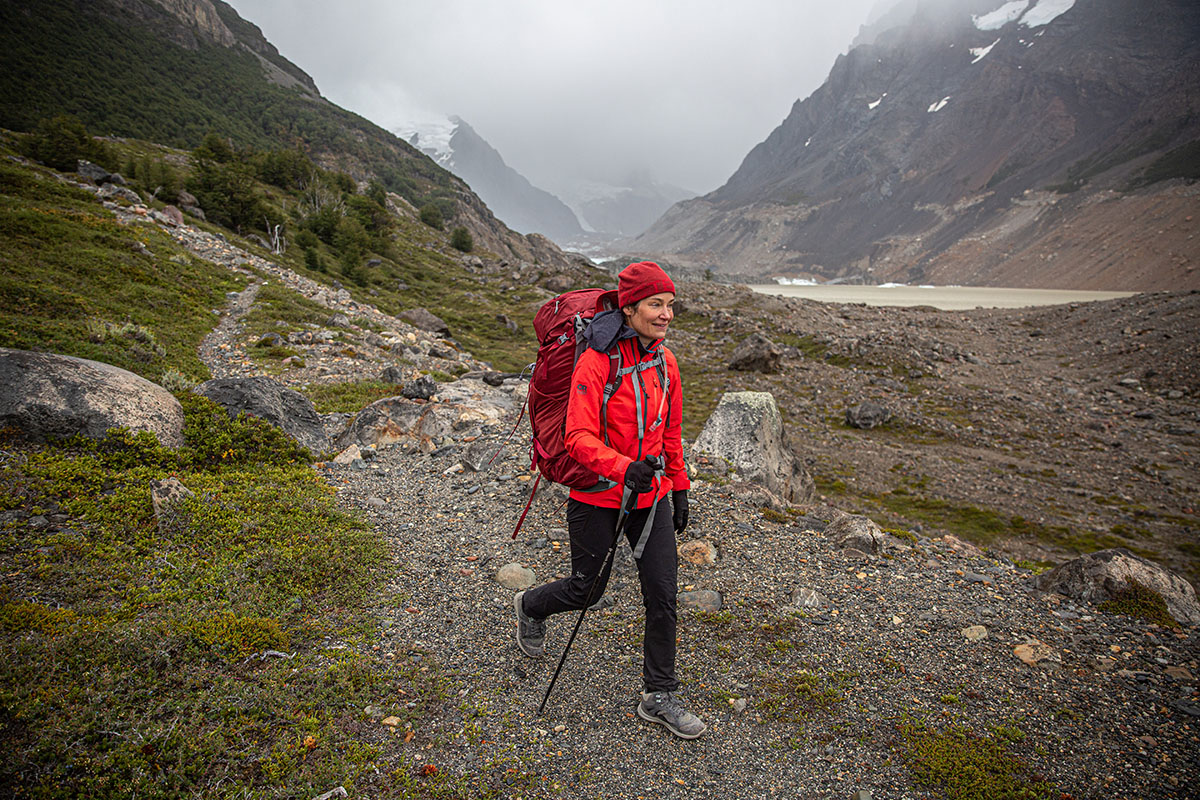
In addition to its quality Gore-Tex build, the Aspire Super Stretch includes a nice array of protection features. For starters, the hem drawcord made it easy to cinch the waist to protect my baselayer and midlayer from the blowing rain and wind we frequently encountered in Patagonia. The hood also boasts a rear toggle, which was effective at dialing in fit and keeping the hood in place in gusty weather. Additionally, the tall collar provides great coverage—with the hood on and the jacket fully zipped, very little of my face was left exposed to the elements. I also appreciated the hook-and-loop cuff closures for securing over gloves, although I wish the sleeves were a little longer for tucking my hands into during inclement weather. Finally, the main zipper is highly water-resistant and backed by a storm flap for added assurance. The hand and chest pockets don’t have YKK zippers like the main zip, but I haven’t had any issues with leakage, even when storing my phone in the chest pocket for extended stretches in the rain. 
Breathability is a bit of a mixed bag with the Aspire Super Stretch. In terms of downsides, the interior has a noticeably clammy and plasticky feel against bare skin. For reference, I’m not prone to overheating but found that I quickly grew warm in the jacket during exertion, and the lining wasn’t particularly adept at wicking moisture. That said, the cleverly executed TorsoFlo vents—essentially extended pit zips that run from the hem to the bicep—make a sizable difference. I don’t often use standard pit zips during exertion (I’m more likely to just remove my shell entirely) but utilized the TorsoFlo vents frequently to tailor airflow depending on conditions and my body temperature. You do sacrifice some protection when they’re fully unzipped, but this was really only an issue in blowing rain, and it was quick and easy to adjust the openings via the two-way zippers.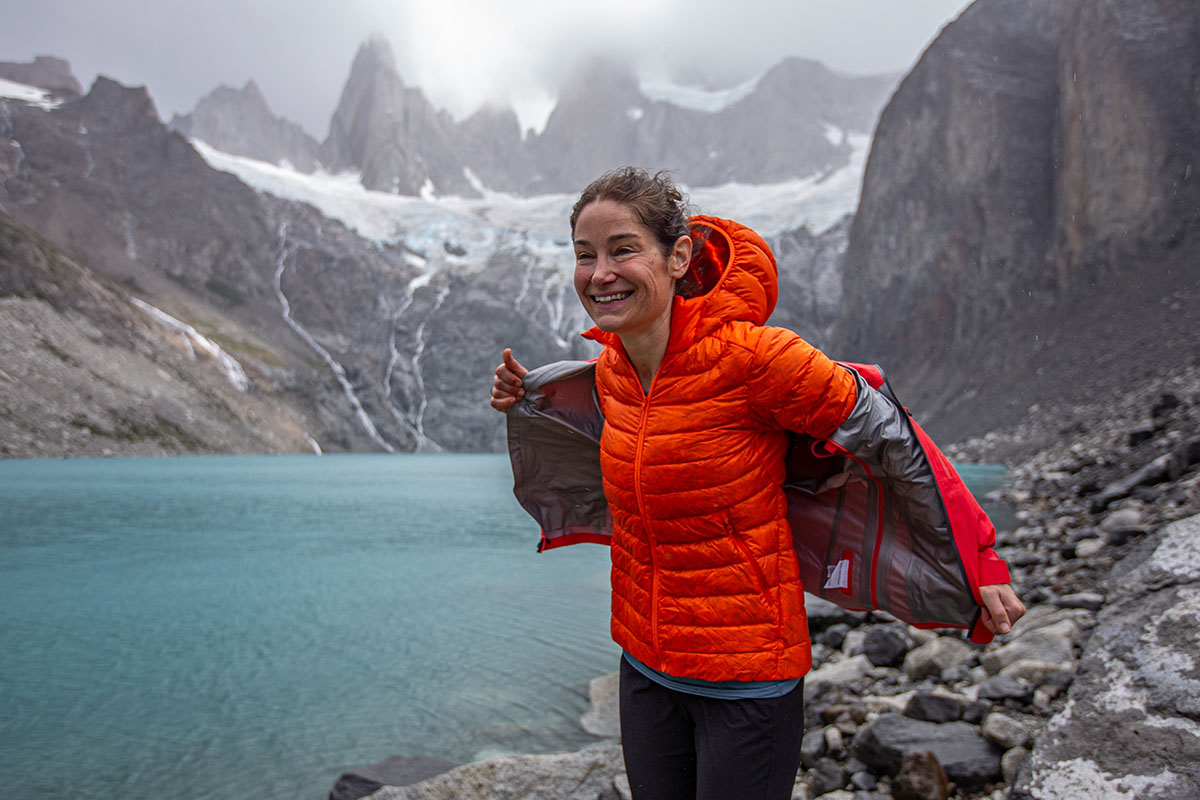
At 12.7 ounces, the OR Aspire Super Stretch Jacket checks in slightly above average in the women’s rain jacket market. For comparison, it stacks up well to everyday-friendly designs like Patagonia’s Torrentshell 3L (12.4 oz.) and Marmot’s Minimalist (13 oz.) but falls short of more performance-oriented options. These include shells like the Rab Downpour Plus 2.0 (11.6 oz.) and minimalist options like the Norrøna Falketind Gore-Tex Paclite (7.8 oz) and Patagonia Storm10 (7.4 oz.). OR’s own Aspire II Jacket is also an ounce lighter and offers very similar all-around performance, although it forgoes the panel of Gore-Tex with Stretch at the back.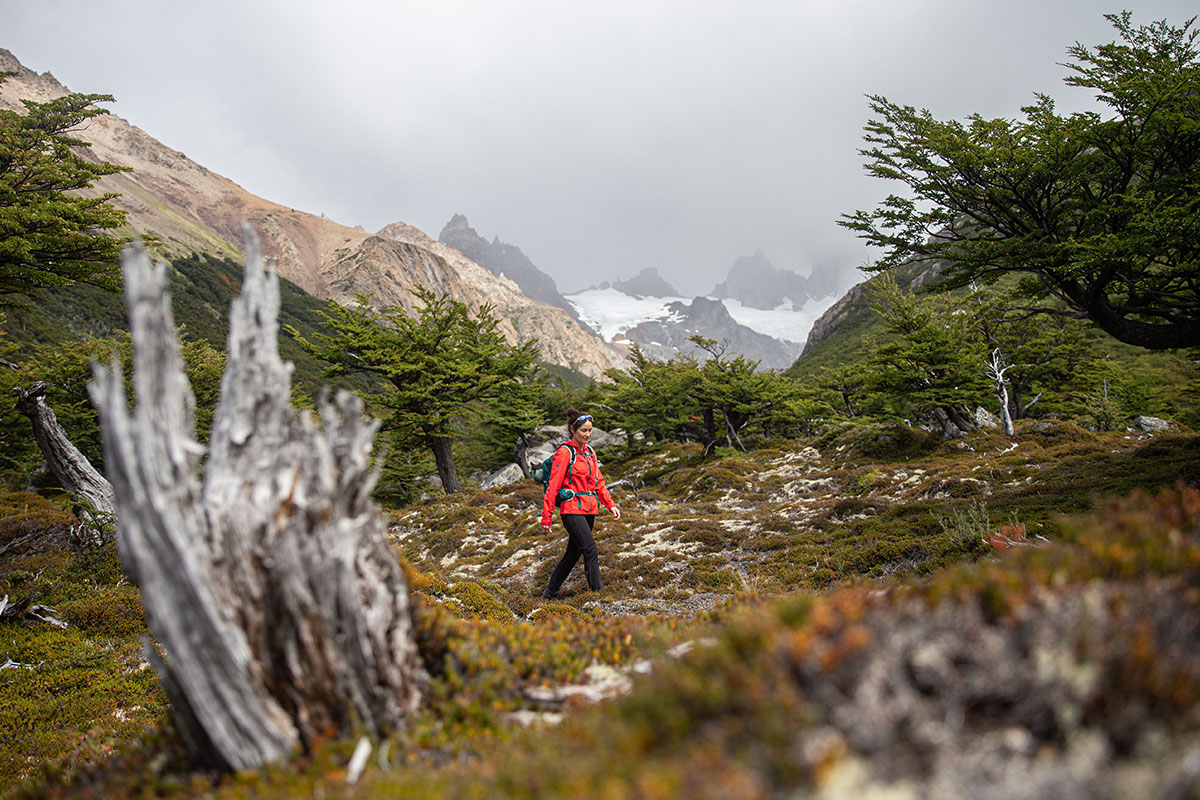
In terms of packability, the Super Stretch Jacket doesn’t have a dedicated stuff sack or pocket but packs down quickly and easily into its hood for storage. You can then use the cinch cord at the back of the hood to compress it down even further. Overall, I was pleased to find that the jacket isn’t at all bulky despite the additional zippers for the TorsoFlo vents, and I’ve had no problems stuffing it into a brimming daypack or backpacking pack.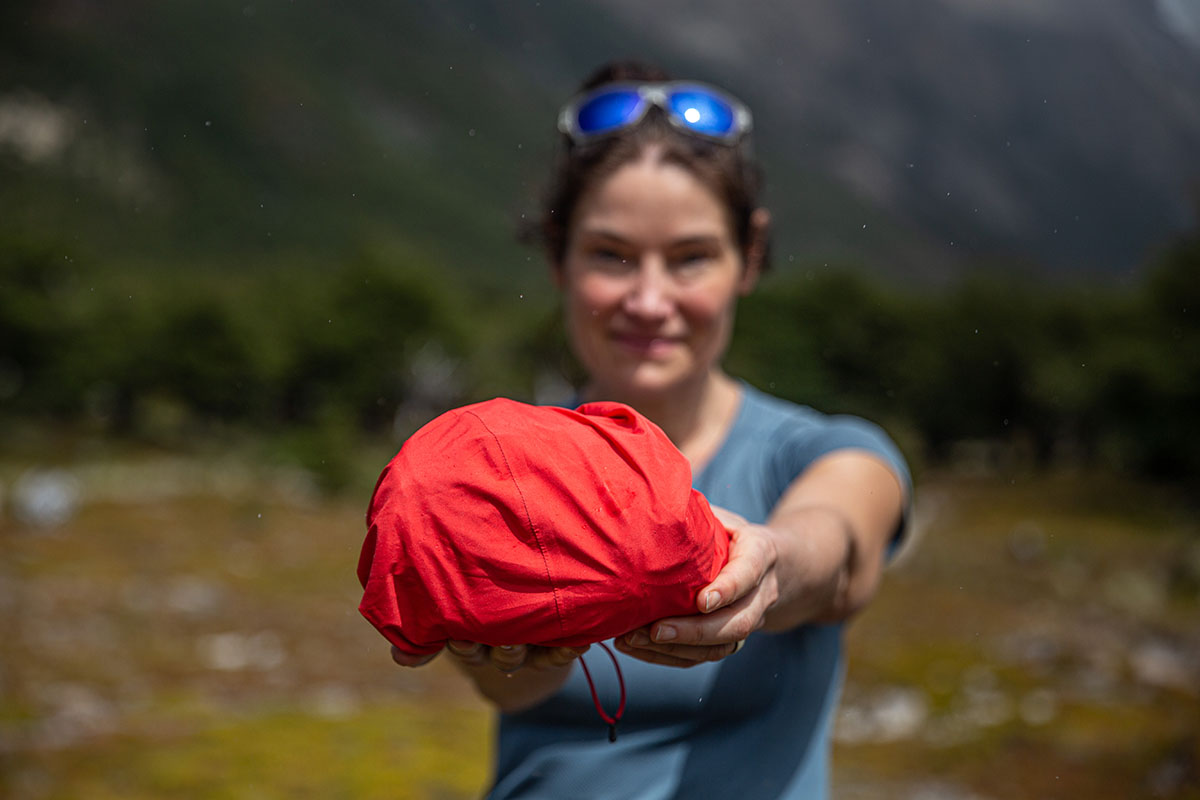
As its name implies, the OR Aspire Super Stretch is very easy to move in. The shell fabric is noticeably supple and flexible—a far cry from the stiff and crinkly feel common among cheaper designs—and the stretchy back panel (which is made with 19% elastane) adds a sizable boost in all-around mobility. I often had to use my hands for balance while ascending steep slopes and navigating boulder fields in Patagonia and never experienced any restriction to movement. This also held true while crossing a Tyrolean traverse en route to our campsite at the base of the Torre Glacier, which required hand-over-hand pulling to propel myself and my pack across the raging river. As I mentioned above, I’m not a huge fan of the lining’s slippery and plasticky feel against bare skin, but that’s easily resolved by wearing a long-sleeve baselayer underneath.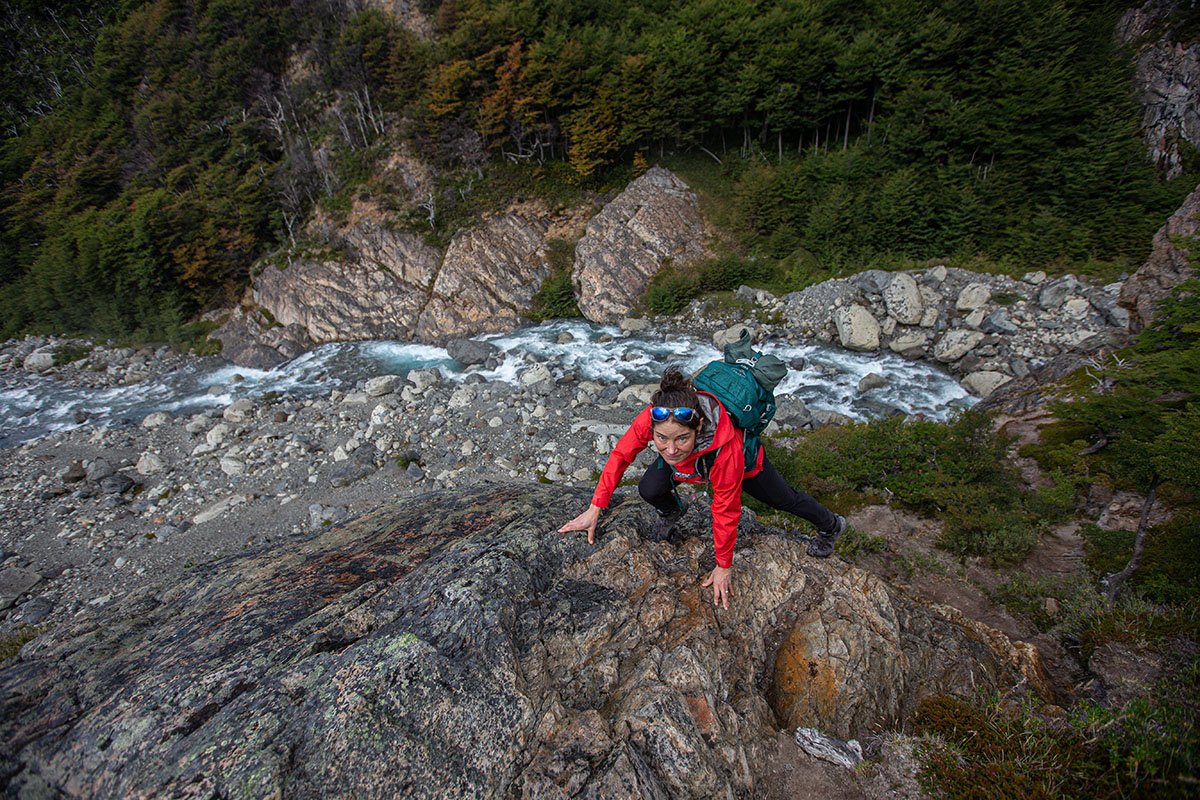
Outdoor Research can be hit or miss in the build quality department, but the Aspire Super Stretch is a decidedly premium and well-made women's rain jacket. For starters, the 50-denier (D) face fabric is noticeably robust and showing no signs of wear or abrasion despite frequent bushwhacking and haphazard packing. All of the smaller components are faring equally well: The seams are all intact with no fraying, the zippers and toggles are operating smoothly, and the DWR coating continues to repel moisture. Overall, I have no qualms about taking the jacket into the backcountry and expect it to hold up well over the long term.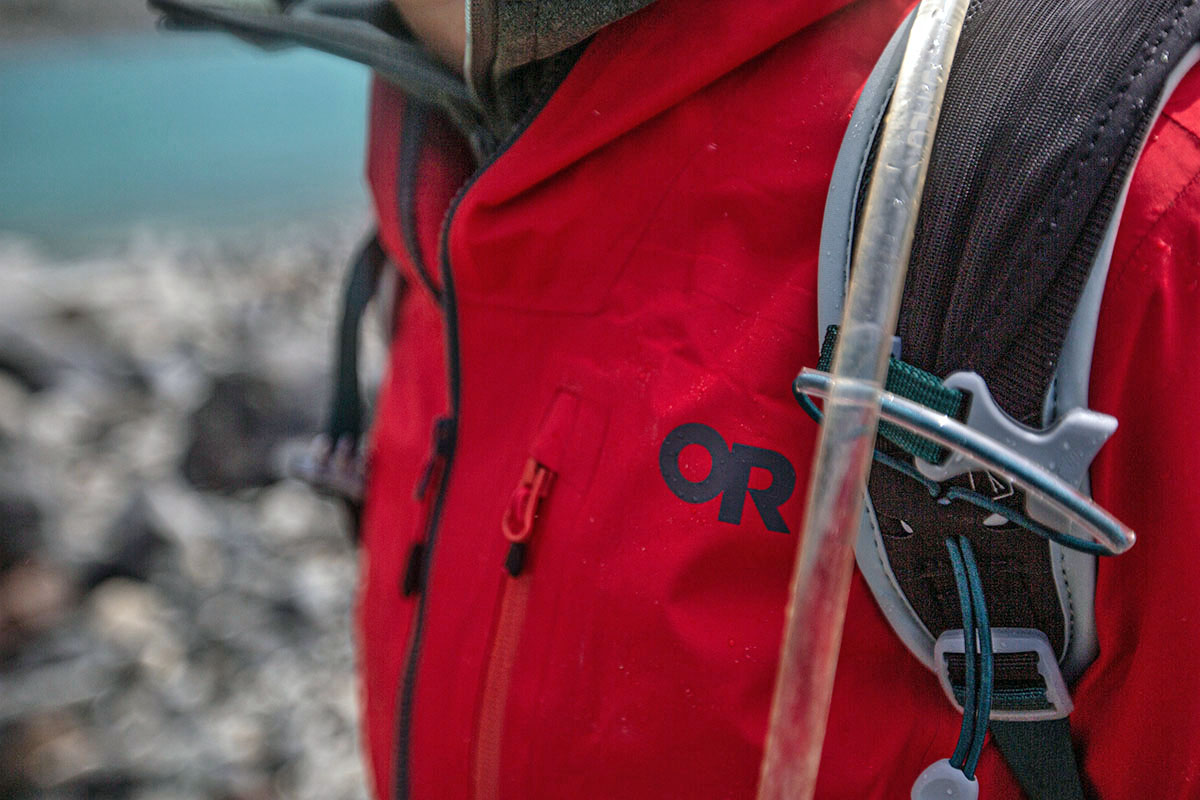
The Aspire Super Stretch’s hood is relatively simple but well executed for everyday and light outdoor use. In terms of adjustability, you get a single toggle at the back that provides an even cinch around the head. The design also boasts a shallow wire brim that’s been effective at deflecting precipitation from dripping onto my face. The hood isn’t listed as being helmet-compatible, but it slides nicely over a low-profile climbing lid (it won’t work with a bulkier ski helmet).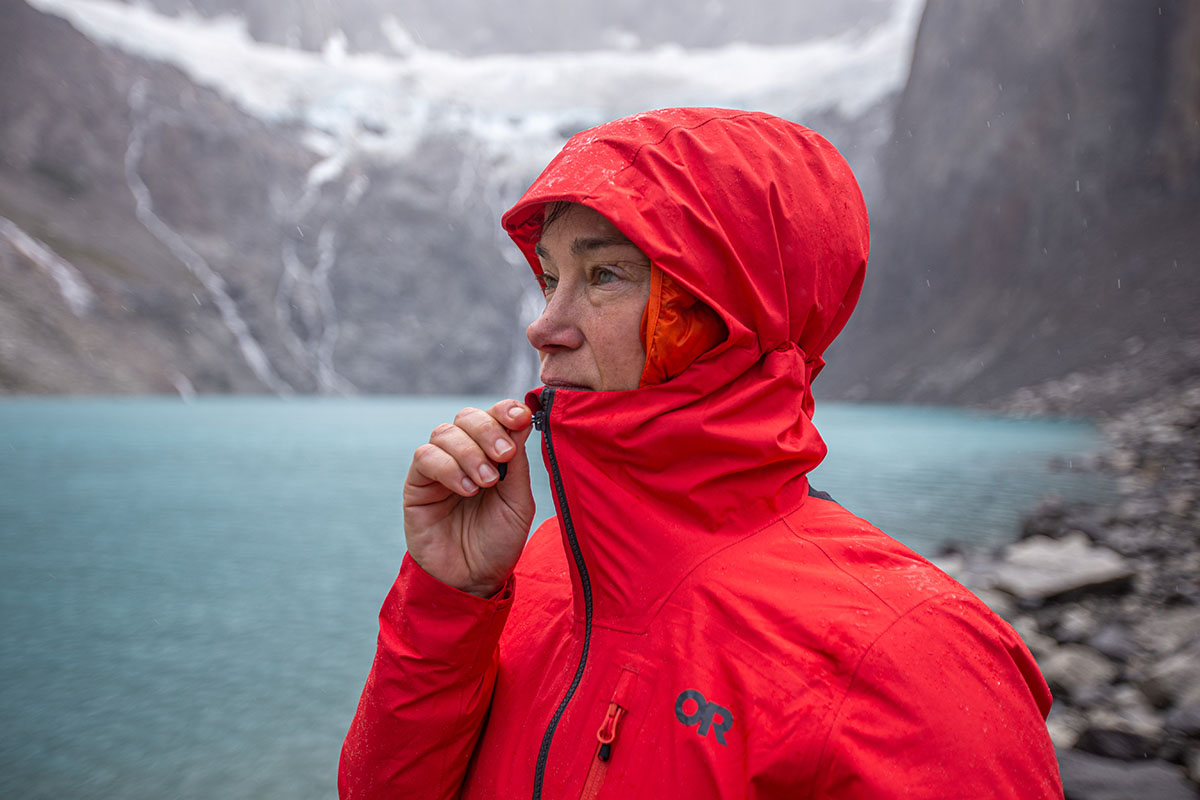
Similar to the hood design, the Aspire’s storage layout is basic but gets the job done. The two zippered hand pockets are generously sized for warming cold hands or stashing extras like a hat and gloves, and there’s a clip inside the left one for attaching a set of keys. They’re not hipbelt- or harness-compatible, which renders them inaccessible while hiking or climbing, but they’re at a natural height when walking around town. You also get an exterior chest pocket that provides a nice spot to stow small valuables like a wallet or phone. It’s worth noting that the pocket zippers aren't water-resistant, meaning there’s a chance moisture could make its way inside, but you do get added assurance in the form of fabric flaps over the hand pockets and a zipper garage on the chest pocket. In practice, I haven’t had any issues with leakage to date and trust the pockets enough to regularly stash my phone.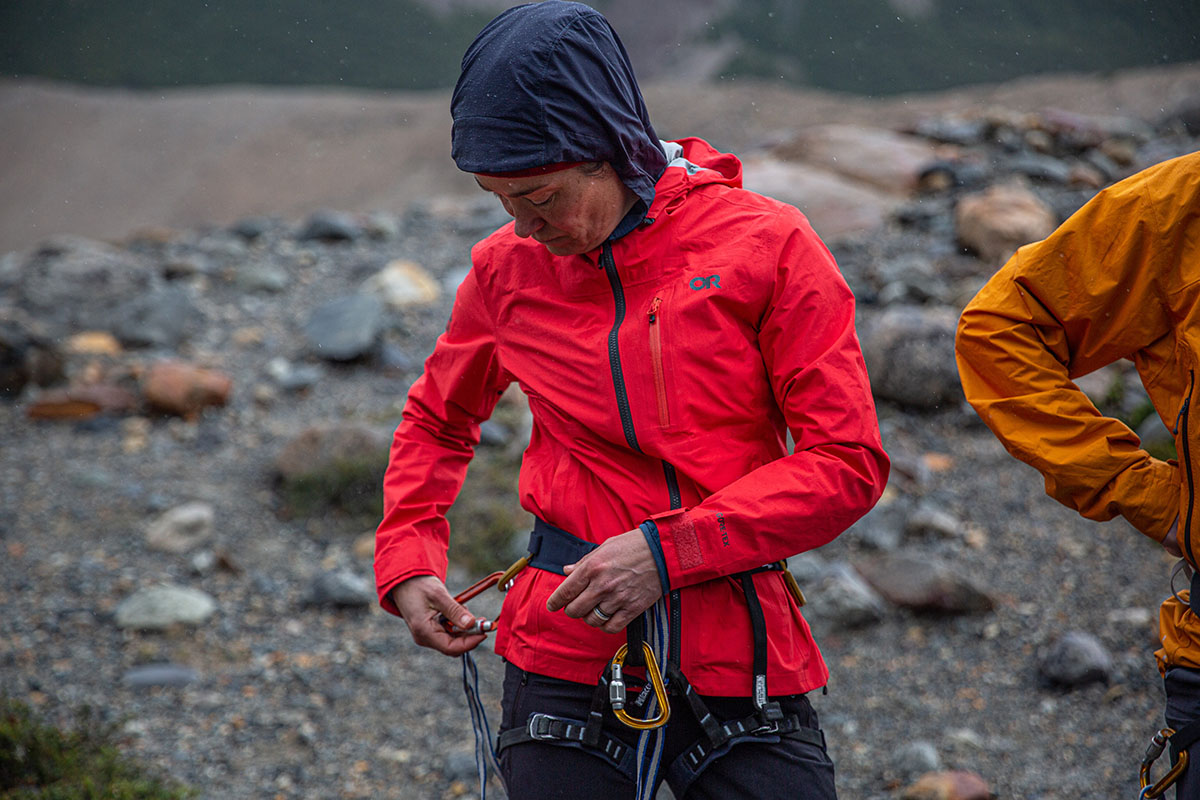
As I touched on above, the Aspire Super Stretch boasts OR’s innovative TorsoFlo side zips that run from the hem to the bicep and feature a two-way zipper to customize venting. I haven’t had to unzip them fully—this creates a poncho-like opening that can ride over your backpack’s hipbelt—and often just unzipped a section under the arms for pit-zip-like venting. Regardless of how you choose to use them, the TorsoFlo vents provide class-leading airflow with minimal downsides. Like I mentioned previously, you do sacrifice some coverage and protection when the vents are fully unzipped, but it’s easy to tailor the opening and nice to have the option to really air things out in mild weather.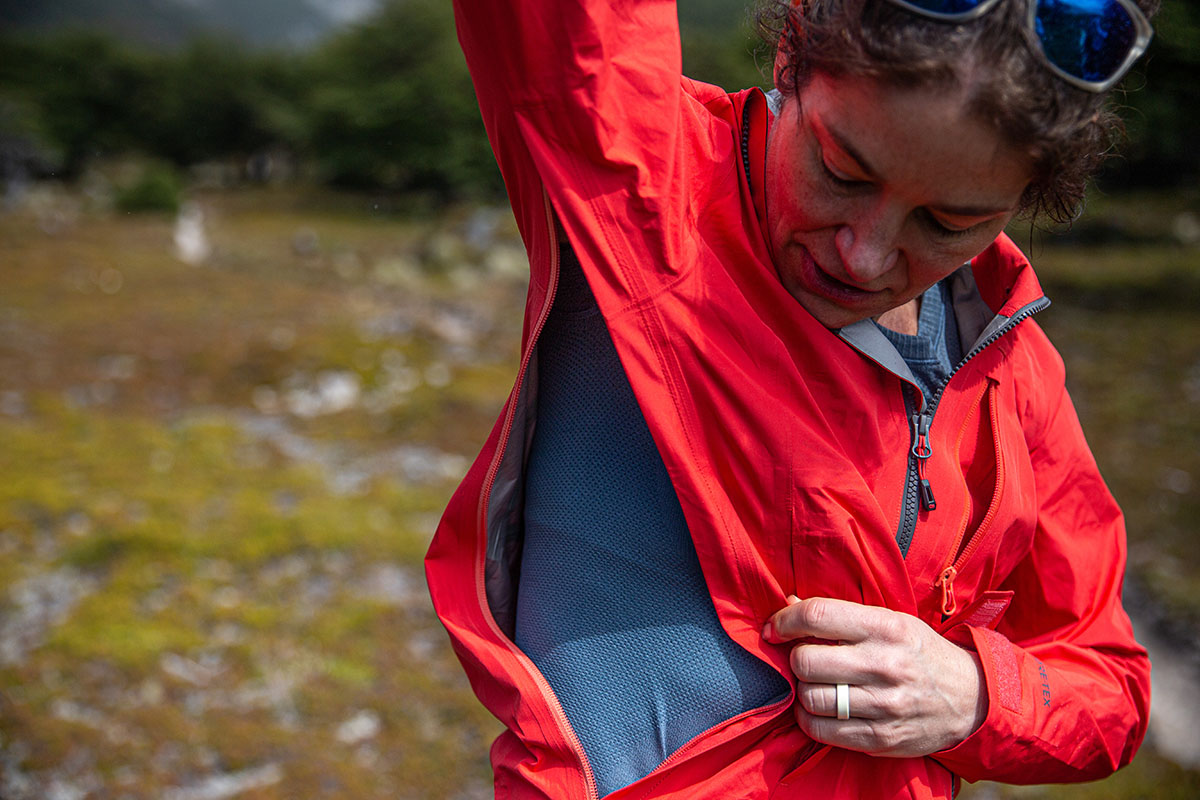
A final feature worth highlighting is the Aspire’s strategically placed stretch panel, which sits at the back between the shoulder blades. Made with a generous 19% elastane, it’s been a boon for mobility—particularly when reaching forward—without any obvious sacrifice in wet-weather protection. It’s worth noting that some competitors (like the Black Diamond StormLine Stretch) instead integrate stretch directly into the build, but I personally like the OR’s hybrid concept and think it’s incorporated well into the design.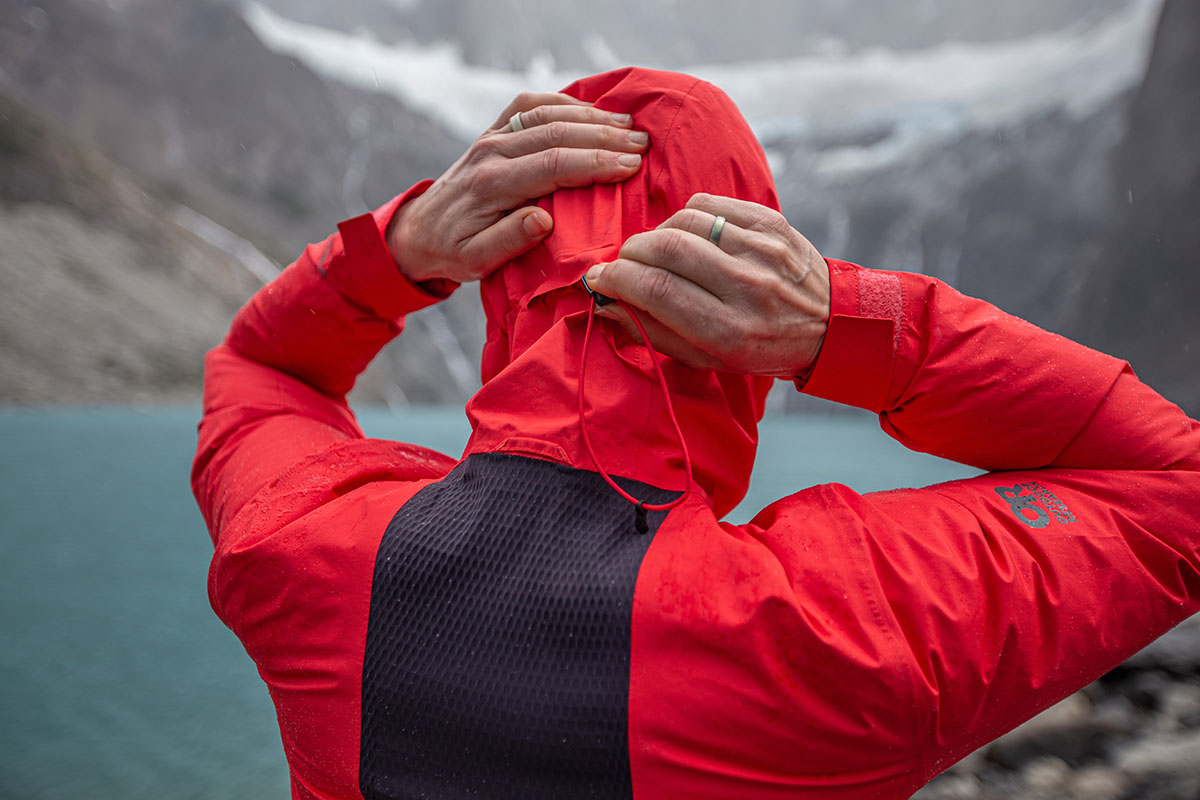
Like many other leading outdoor brands, Outdoor Research has started making many of their pieces with an eye toward sustainability. In this case, the Aspire Super Stretch Jacket utilizes a 100% recycled polyester shell and bluesign-approved fabrics that meet strict environmental standards and have been deemed safe for workers, consumers, and the environment. Finally, the DWR coating is PFC-free, which indicates that it’s made without the use of harmful perfluorocarbons that are notorious for their inability to break down over time. Added up, it’s a competitive all-around effort and a nice reflection of OR’s ongoing sustainability push.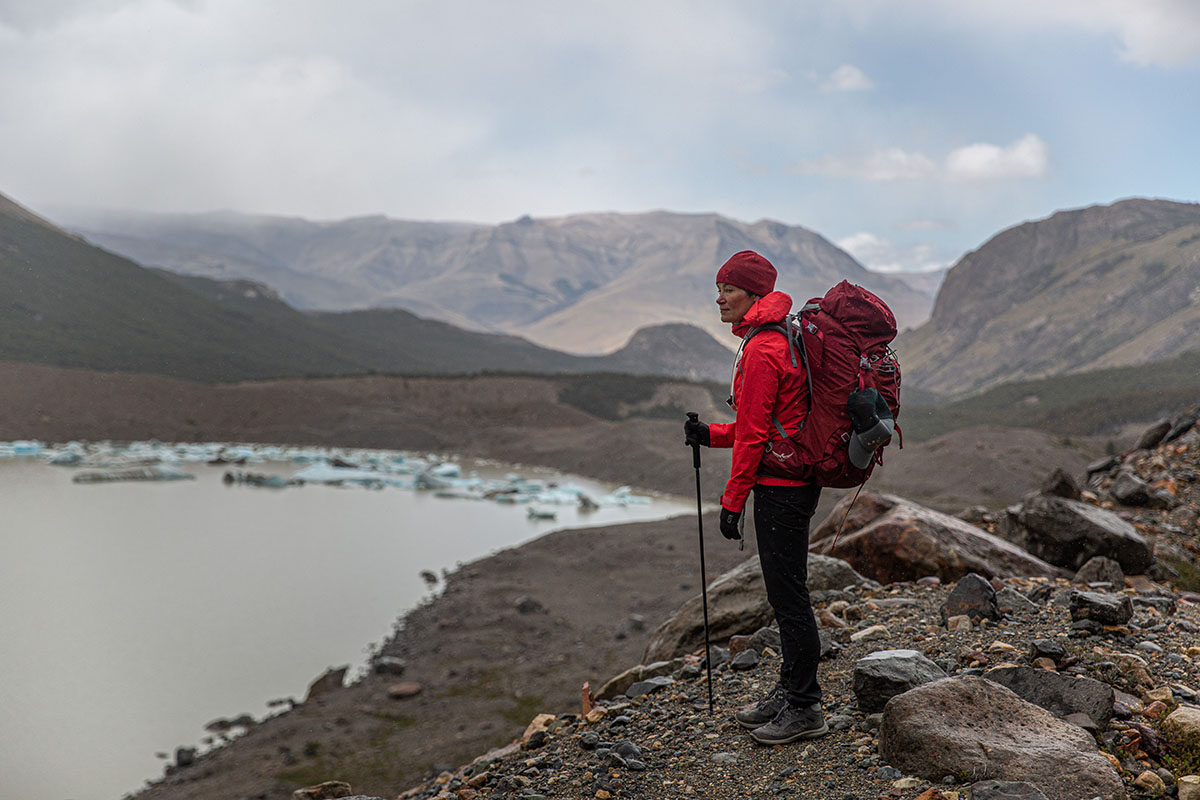
The Aspire Super Stretch Jacket is offered in six sizes for women (XS to XXL), and my usual size small was just about perfect for my 5’8” frame. For reference, the “standard” fit easily accommodates a midlayer underneath (often my Arc’teryx Cerium SV) while maintaining a flattering shape that’s not overly roomy. The hem length is also spot-on for me, falling just below my hips. My only complaint is that I found the sleeves to be a little short—I love to tuck my hands into the cuffs in colder temperatures but couldn’t do this with the Aspire Super Stretch (although not all women will have this issue).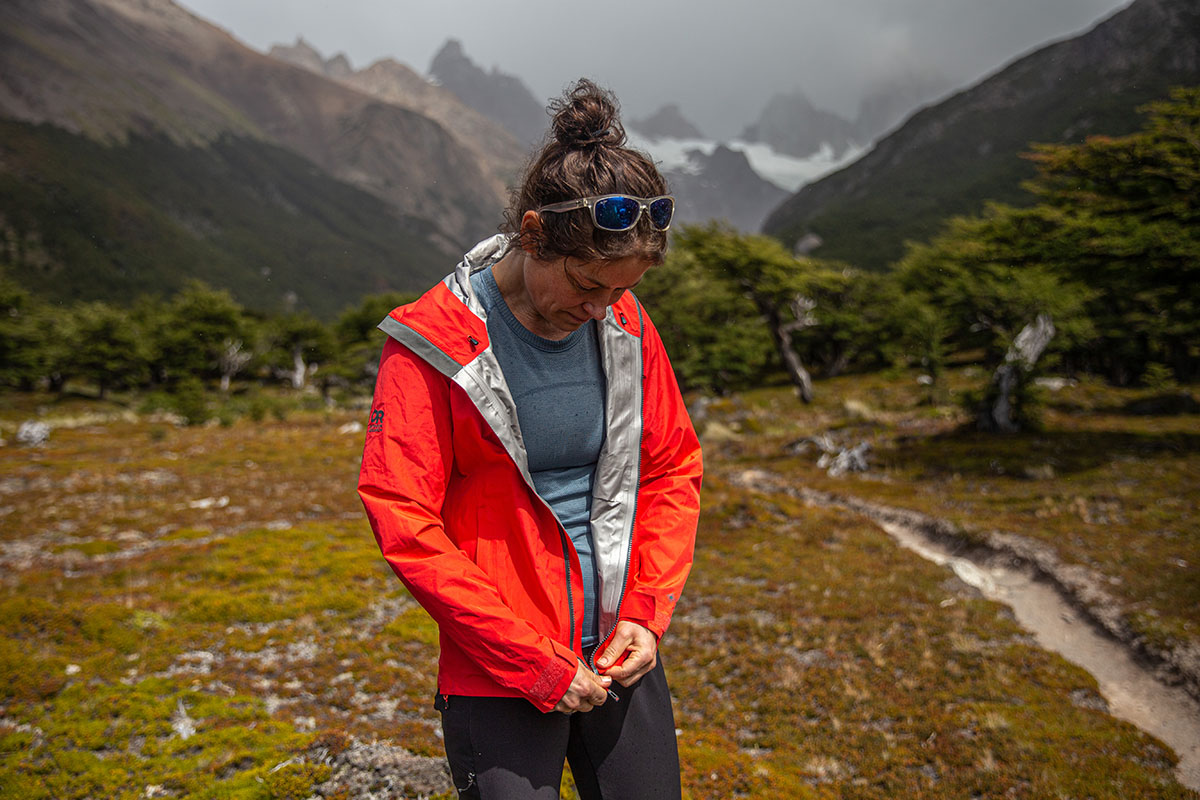
The Aspire is a women’s-specific design, and Outdoor Research’s men counterpart is the Foray. Stacked up against the design tested here, the men’s Foray Super Stretch Jacket costs the same at $300 and retains an identical overall build and feature set but checks in a little heavier at 14.5 ounces and comes in different colorways. We haven’t had a chance to test the men’s version yet but expect overall performance to be largely similar.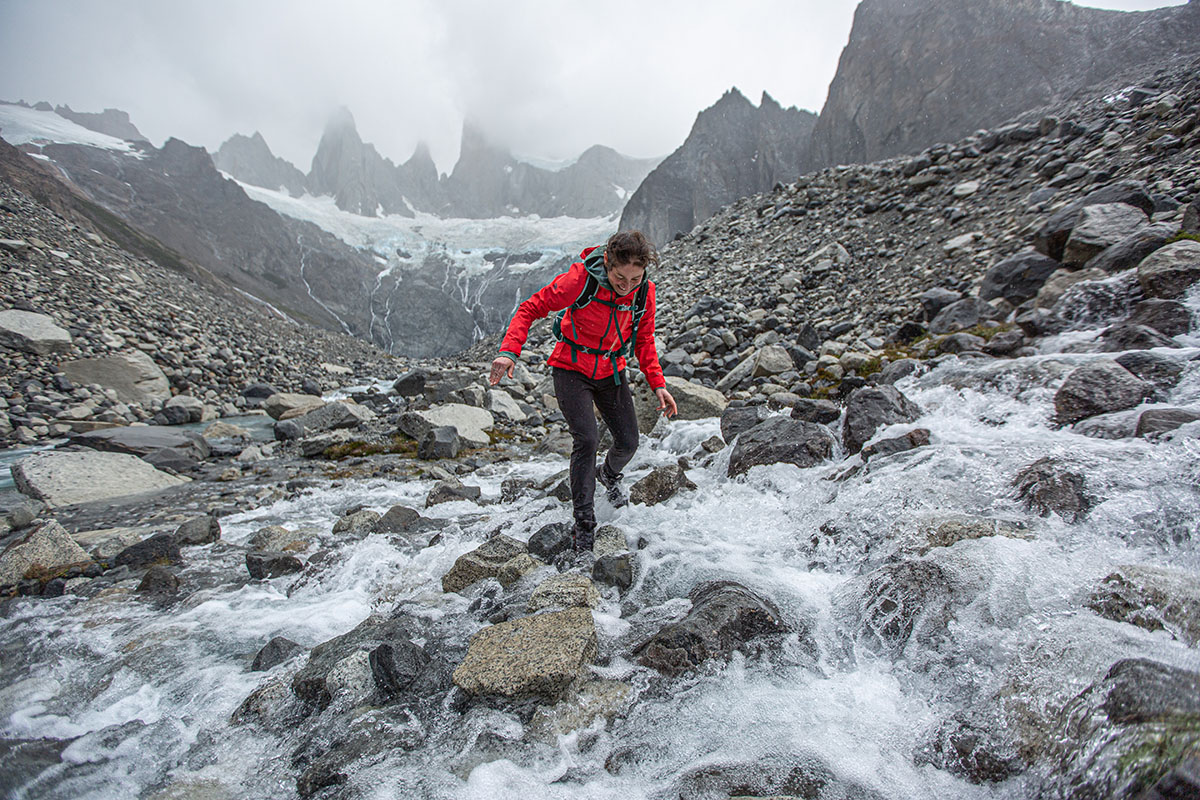
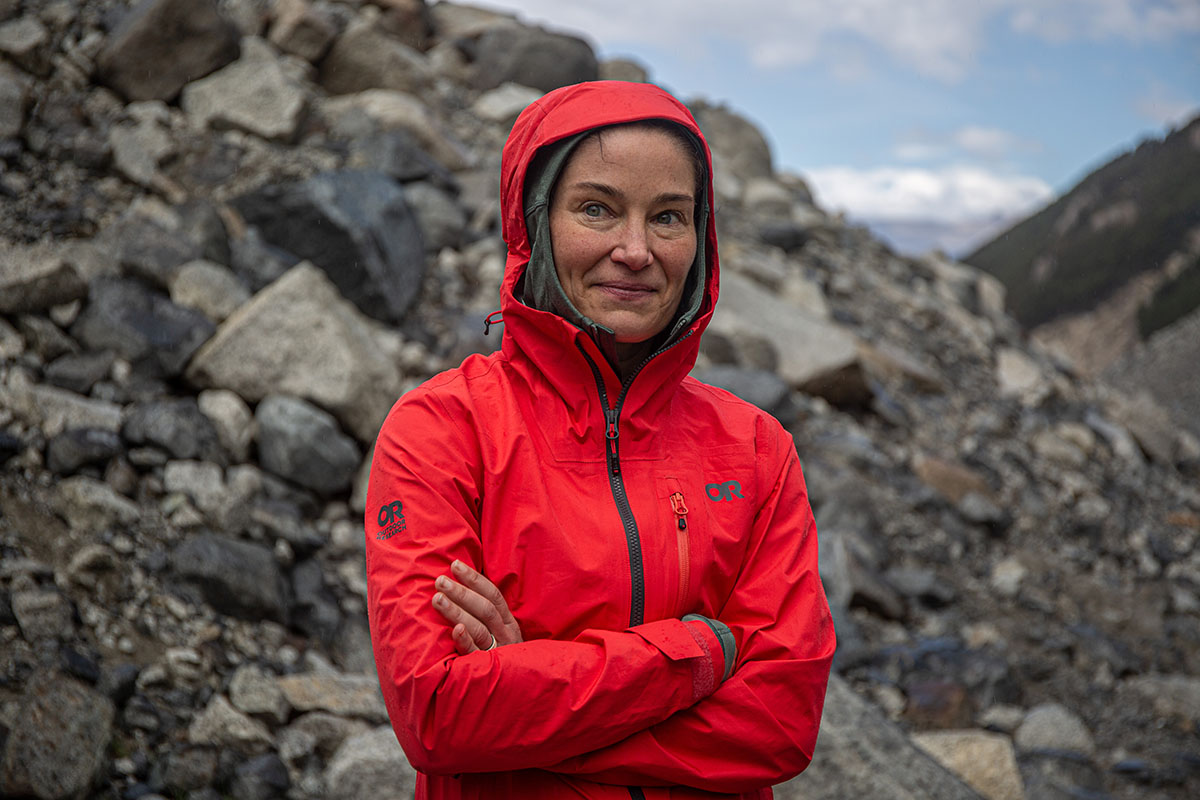
| Jacket | Price | Weight | Category | Waterproof | Shell | Pit Zips |
|---|---|---|---|---|---|---|
| OR Aspire Super Stretch | $300 | 12.7 oz. | Hiking/daily use | 2L Gore-Tex | 50D | Yes |
| Outdoor Research Aspire II GTX | $225 | 11.7 oz. | Hiking/daily use | 2L Gore-Tex | 50D | Yes |
| Black Diamond StormLine Stretch | $170 | 9.5 oz. | Hiking/daily use | 2.5L BD.dry | 50D | Yes |
| REI Co-op XeroDry GTX | $169 | 10.6 oz. | Hiking/daily use | 2L Gore-Tex | 50D & 75D | No (vents) |
| Patagonia Torrentshell 3L | $179 | 12.4 oz. | Daily use/hiking | 3L H2No | 50D | Yes |
The Aspire Super Stretch stands out in the women’s rain jacket market for its effective mix of protection, mobility, and durability, but it’s not the cheapest or lightest option available. For a considerable $75 less and an ounce lighter, it’s worth considering OR’s standard Aspire II GTX Jacket. Like the Super Stretch, the Aspire II utilizes a 2-layer Gore-Tex Paclite build with a hardwearing 50D face fabric and boasts a largely similar feature set that includes an adjustable hood (with two additional toggles), TorsoFlo vents, three total pockets (one of which has a key clip), hook-and-loop cuff closures, and a hem drawcord. The only notable omission is the stretch panel at the back, although we found the supple polyester face fabric to be unrestrictive during activity. The standard Aspire is also available in a wider selection of colorways and sizes, including dedicated plus sizes. If you don’t mind the lack of stretch, we consider it the better all-around value and a great quiver-of-one shell for backpacking, spring skiing, and daily use.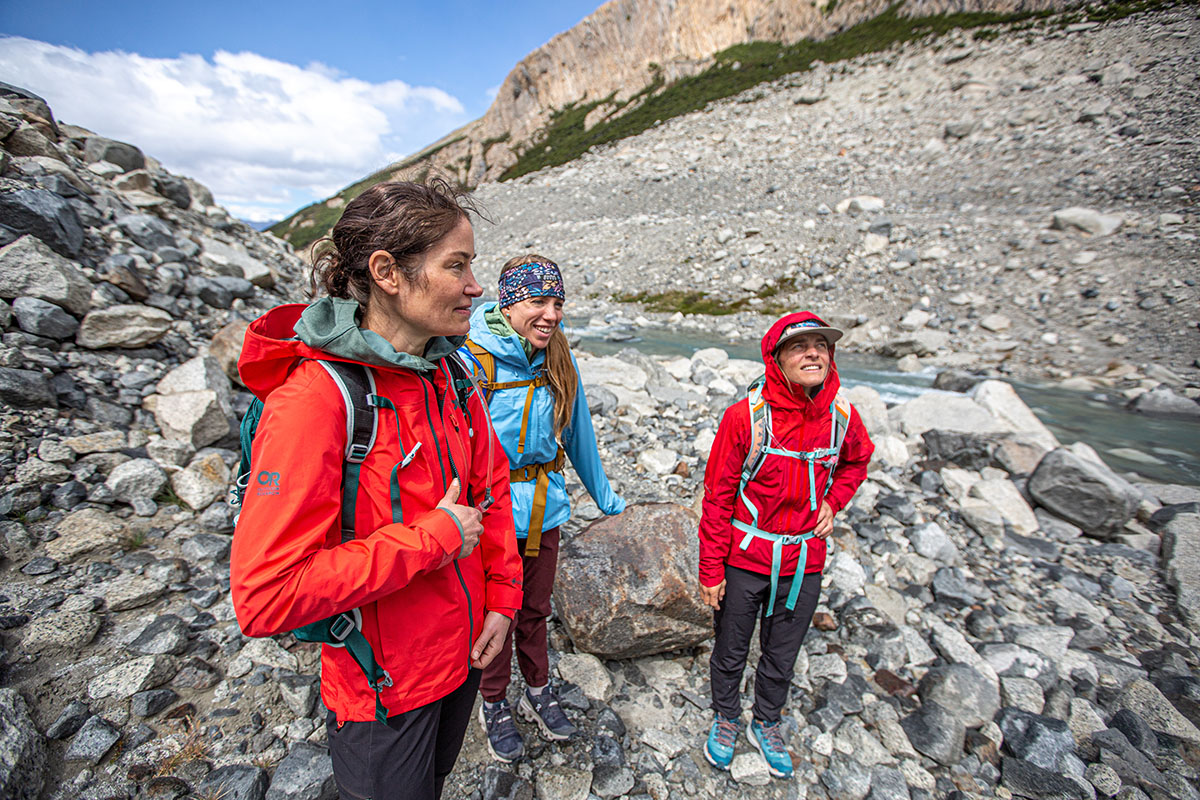
Stretchy rain jackets are on the rise, and our current favorite is Black Diamond’s StormLine Stretch Rain Shell. For a whopping $130 less than the Aspire Super Stretch, the StormLine checks in notably lighter at just 9.5 ounces and has a flexible 2.5-layer construction that offers a soft next-to-skin feel and ample mobility for hiking and other outdoor pursuits. It also comes well equipped with two hand pockets, pit zips, a coated front zipper, a helmet-compatible hood, and adjustability at the cuffs and hem. Neither jacket is a standout in breathability, but we give the slight edge to the OR thanks to its more generous TorsoFlo vents that run from the bicep down to the hem. However, that’s not enough to offset the substantial price difference, earning the BD our overall endorsement over the Aspire Super Stretch.
Next up is REI Co-op’s XeroDry GTX, which shares the Aspire Super Stretch’s 2-layer Gore-Tex Paclite construction but retails for just $169 (and is currently discounted by 30%). It’s also lighter at 10.6 ounces while retaining a similar feature set that includes two hand pockets and one chest pocket, hook-and-loop cuff closures, and a hem drawcord for sealing out drafts at the waist. In parsing out the differences, the XeroDry has a more practical hood design with three drawcords (two at the front and one at the back) for a more dialed-in fit and a loop at the back to tuck it away when not in use. However, it falls short in mobility with no elastane built in, and the hand pocket vents are far less effective than the OR’s TorsoFlo design for dumping excess heat (plus, opening them up means you can't rely on the pockets for storage). In other words, the Aspire Super Stretch wins out from a performance perspective but falls well short in value.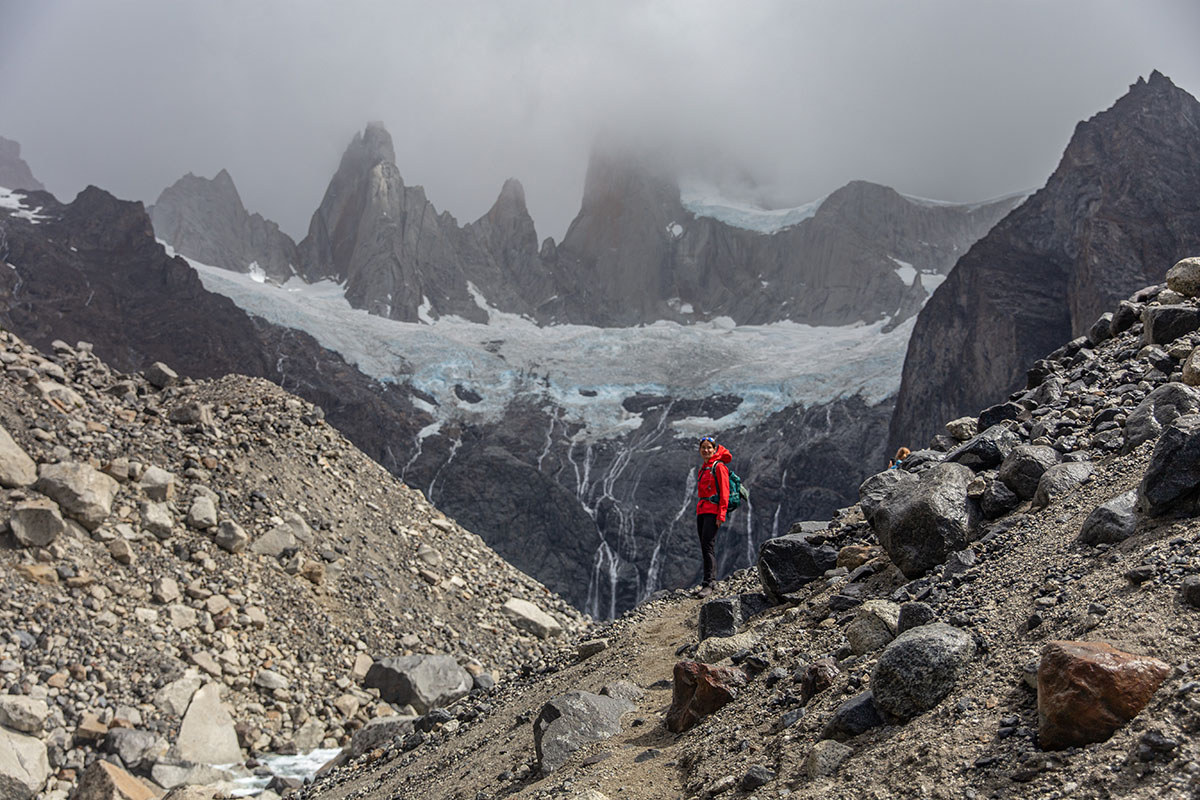
Last but certainly not least is Patagonia’s Torrentshell 3L, which is our favorite overall rain jacket this year. For a very approachable $179, the Torrentshell boasts a performance-ready, 3-layer H2No build that offers trustworthy protection and better breathability than the OR’s 2-layer design. It also has a similarly durable 50D face fabric, checks in around the same weight (12.4 oz.), and retains features like an adjustable hood with a laminated visor (that stows away when not in use), pit zips, and the ability to cinch the hem and cuffs. You don’t get a chest pocket or any stretch in the build, and the OR’s fit is notably sleeker and more streamlined than the Patagonia’s fairly boxy cut. The Aspire Super Stretch also has a considerably more flexible and supple shell—the Torrentshell is noticeably stiff and noisy by comparison (for more, see our in-depth women’s Torrentshell review). But again, you’d be hard-pressed to find better performance for less.
If you’re thinking about buying gear that we’ve reviewed on Switchback Travel, you can help support us in the process. Just click on any of the seller links above, and if you make a purchase, we receive a small percentage of the transaction. The cost of the product is the same to you but this helps us continue to test and write about outdoor gear. Thanks and we appreciate your support!
Depending on the seller, most products ship free in the United States on orders of $50 or more. International shipping availability and rates vary by seller. The pricing information on this page is updated hourly but we are not responsible for inaccuracies.